
To my family
Contents of ebook 2
 Chapters 610 are in ebook 2, ISBN 978-1-910591-02-4, available from your ebook retailer.
Chapters 610 are in ebook 2, ISBN 978-1-910591-02-4, available from your ebook retailer.
Foreword
Preface
Introduction
6 Jumpstart Guide to Key Tracking Methods
7 Data Responsibilities
8 Building Your Insights Team
9 Using Key Performance Indicators and Dashboards
10 Insights and Success Stories
Appendix: Terminology Explained
Index
Foreword
If you have $100 toinvest in magnificent, glorious success from your analytics efforts, invest $10 in tools and implementation and invest $90 in big brains (people!).
I humbly postulated that ground truth as the 10/90 rule on May 19, 2006. With every passing year, Ive come to believe in that rule more and more (and more and more). The reason is quite simple. Every facet of the business world is throwing off ever more data, and every facet of our personal existence (and insistence on sharing) is throwing off ever more data. Data, it turns out, is free; identifying specific actions business leaders can take based on rigorous analysis is not free.
This is why Im so excited about Brians book. It dispenses with the normal omg, omg, look at how much data is there and is that not amazing, let us spend 18 months on implementation, and gets to what it really takes to shift from data puking to recommending business actions based on data.
Heres one of my personal examples of the difference in emphasis, and what ultimately drives success. In every company, every leader wants a dashboard. Get me a summary of the business performance. Decisions shall be made! Analysts scurry around and an intense burst of data, manifested as tables and charts, is presented on a vanilla-scented piece of paper. Happiness? Job promotions?
Sadly, no.
It turns out that the higher you go up the chain of command, the more analytical skills go down, and the context required to make sense of the numbers on the dashboard is also dramatically reduced. Few decisions are made, and if there is a meeting to discuss this it devolves into a discussion of the data quality, missing data, colors in charts, and everything except making a business decision.
The answer? Words in English. More specifically: insights, actions, business impact.
Every dashboard in the world should include as few tables and charts as possible. It should include insights written in English (or your native language) by the analyst, followed by the recommended actions andthe most important critical must-have bitthe impact on the business if the actions are taken.
That vanilla-scented piece of paper will no longer drive one more awful discussion about the data itself; it will drive a discussion of which actions to take first. Hallelujah!!
It is incredible to realize that in the end, data by itself does nothing. It is just data. It is the $90 partthe big brainsthat identifies insights, actions, and business impact that will push your companys profitability and customer delight to new, incredible, heights.
Next time you receive a dashboard, look for the balance between tables, charts, and English text, and youll know if it will add value or waste time.
Thats my little appetizer for you as you dive into Brians wonderful book.
The entire book is awesome. It is beautifully structured, and you should go from Chapter 1 to Chapter 10 on your we will make the most of data voyage. But if you wanted to be a little naughty and jump around, my favorites are Chapter 8 (you can read it anytime, and you cant work on the recommendations soon enough!) and Chapter 10 (every time you find a task daunting, find hope in the success of others in the case studies).
I wish you all the very best. Carpe diem!
Avinash Kaushik
Digital Marketing Evangelist: Google
Author: Web Analytics 2.0, Web Analytics: An Hour a Day
Preface
This is my fourth book on Google Analytics, but this one is different. Rather than making it a tool-specific practitioners bible (as my Advanced Web Metrics series endeavored to be), I approached this book as I do my work: helping ambitious organizations make a success of their business by using data intelligently.
As I have come to realize over the years, success does not depend on tool expertise alone. The bigger issue is the organization. It needs to trust the data and have confidence in the process, structure, and people behind itthings not directly related to the tools being used. So I approached this book very much from the business point of view first, then worked backward toward the nontechnical aspects of the toolGoogle Analytics. My intention is that senior managers, stakeholders, and practitioners all speak a shared language and set a common path to building a credible data-driven environment. I hope the method has worked.
As for all authors, my writing of this book was not a solo exercise. It required love, support, help, guidance, advice, friendshipeven random and unrelated conversations. (You would be surprised at what can spark an idea connected with data!) The people I list here are those who have directly contributed to the book or to my thinking about applying successful analytics.
Sara Cliftons never-ending love, support, and guidance keep me on the right track and always help me to see the bigger picture of measurement, digital, and life in general.
Shelby Thayer has sanity-checked every word of my last three books, including this one. She is a great analyst, with a ton of experience at driving web measurement acceptance within a large organization, and her feedback and experiences have helped me significantly in writing a tightly focused book.
Brad Townsend is my valued technical editor. He is a smart (and modest) Googler who, as a software engineer, knows the technicalities and back end of Google Analytics like no other. David Vallejo, an expert Google Analytics implementer, developer, and all-round smart guy, helped me enormously with his technical problem-solving skills. Nothing cant be done with this guy at hand! Dave Evans expertly reviewed Chapter 7 (Data Responsibilities) and provided insightful discussions about data privacy law. Dick Margulis is my trusted editor, who has now helped me write and structure three books and is my go-to man for navigating the tricky waters of the publishing world. His guidance and advice have been invaluable.
Avinash Kaushik has honored me (again) by writing the foreword to this book and setting the scene so enthusiastically and logically for the readerin a way that only he can. I am lucky to count him as a friend and former colleague. He inspires me (and many others) with his advocacy and excitement for all things that can be measured.
John Wedderburn, Tobias Johansson, and the team at Search Integration (where I work) have engaged in many quality time meetings and open-ended discussions that have broadened and deepened my knowledge.
And last but not least, the vibrant and smart GACP community pushes back the boundaries of what can be done with Google Analytics, and importantly, what can be simplified with it.
I hope I have remembered everyone.
Brian Clifton
January 2015
Introduction


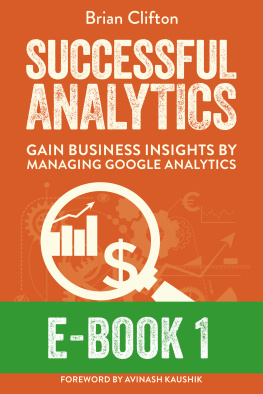
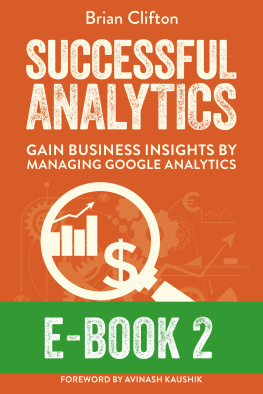



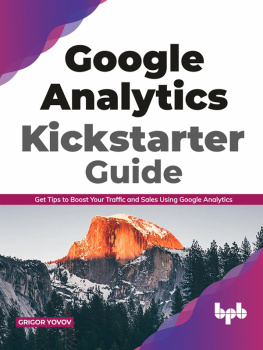
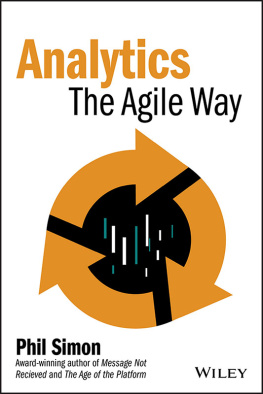

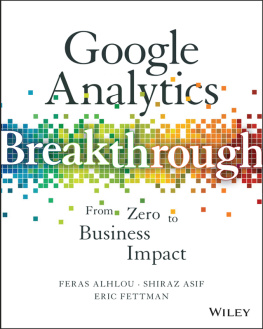

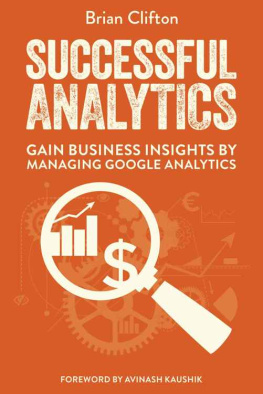
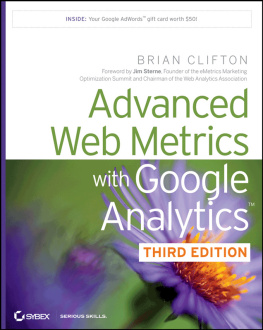


 Chapters 610 are in ebook 2, ISBN 978-1-910591-02-4, available from your ebook retailer.
Chapters 610 are in ebook 2, ISBN 978-1-910591-02-4, available from your ebook retailer.